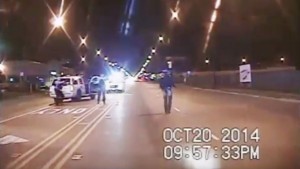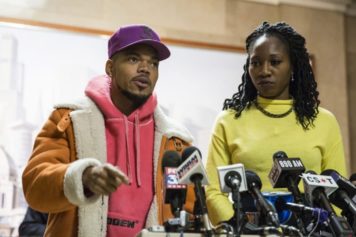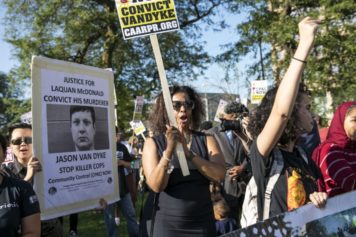
First, there is the video itself, which shows Officer Jason Van Dyke unloading his weapon into the body of a Black child. There are eight police officers on the scene, and Van Dyke is the only officer firing his gun. And what he does with that gun tells us the story. Van Dyke shoots Laquan, who falls to the ground, and proceeds to empty his gun as his victim is down. Nine of the sixteen shots strike Laquan in the back. He does not “lunge” at the officer, as per the official police narrative, as he is walking away from the officer. And once the young man is riddled with bullets, he is left to lay there to die, on the pavement like a dog, without anyone to help him.
Lest we risk over-analyzing a video that is resolutely shocking to the conscience, and in the process fail to see the forest for the trees, New York Times columnist Charles Blow made a point on CNN last night. Blow argued that the video is shocking, but that in trying to analyze individual videos, “ we are losing sight of the largest sociological and historical moment that we are witnessing as a country. That this would not be happening if America did not allow it to happen, either consciously or subconsciously.”
Blow noted this represents a danger to democracy, when groups of people do not have faith in their institutions.
“This is about human beings and how we want our fellow citizens to be treated in our country,” Blow said. “And until we as a society say that that is the how our police officers operate, then we are kind of undermining our own society.”
He added that we cannot consider Laquan to be collateral damage because most officers are trying to do their job, but rather we must realize the police are drawn from society and reflect the bias of the greater society.
The backstory to the Laquan McDonald video is the official cover up surrounding the murder, the lack of transparency and the apparent goal to deceive the public, for which city officials, including the mayor, the police chief, the county prosecutor and others should be removed from office.
Given that the authorities were in possession of this video from the beginning, there is no reasonable explanation as to why it took 400 days to release this video. While the city of Chicago and the police department had the video, they perpetuated the narrative of Laquan McDonald as the criminal and Jason Van Dyke as the officer who justifiably acted in self-defense. Mayor Rahm Emanuel knew about that video all along, and facing a tough re-election battle, made every effort to suppress that video footage. Yet now, he expresses his outrage over the killing, condemns Van Dyke for his conduct, and reaches out to community leaders to maintain calm. This is the mayor who played an active role in the cover up, and blamed an increase in crime in Chicago on the #BlackLivesMatter movement and the backlash against police violence.
Speaking last month at a meeting convened by Attorney General Loretta Lynch in Washington, D.C., Emanuel said the nationwide push for increased law enforcement accountability is making cops go “fetal.”
“Officers themselves are telling me about how the news over the last 15 months impacted their instincts: Do they stop or do they keep driving?” he told reporters last month. “They don’t want to be a news story themselves, they don’t want their career ended early, and it’s having an impact. And I tried to speak up for the good officers that are doing community policing that make up the men and women of the Chicago Police Department.”
Meanwhile, there is no audio accompanying the dashcam footage, and there is also the issue of the 86 minutes of footage that Chicago police deleted from a nearby Burger King surveillance camera. As NBC Chicago reported, after the shooting, four to five police officers entered the restaurant and asked to view the video and were provided the password to the equipment. Three hours later they left, according to the Burger King district manager. The following day, an investigator from the Independent Police Review Authority requested the footage for viewing, only to discover that the 86 minutes of video was missing.

“My husband is having a bond hearing and if we do not raise the money he will be detained on 11/24/15,” the GoFundMe post read. “With the holidays approaching our husband and father needs to be home with his family.” Before it was take down, the page had raised over $10,000 of an $80,000 goal. And Laquan McDonald will not spend the holidays, or any other holidays, with anyone.
This recent chapter in the struggle for Black lives comes as society, particularly the majority of white America, remains in denial over systemic racism. A recent study conducted by CNN and the Kaiser Family Foundation found that 49 percent of Americans say racism is “a big problem” in society today. Although that reflects an increase over the years, there is a wide racial disparity. For example, while 66 percent of Blacks and 64 percent of Latinos say racism is a problem, only 43 percent of whites agree. Among whites, 56 percent of white Democrats 
Meanwhile, according to the poll, 53 percent of Blacks and 36 percent of Latinos said they experienced unfair treatment based on race in the last 30 days. And the study revealed that the vast majority of whites live in a segregated, white world, in which seven in 10 mostly live around and socialize with whites, and six in 10 work in mostly white environments. Blacks and Latinos, on the other hand, live, work and socialize in more diverse environments.
So, what will it take? A majority of whites have their heads in the sand and do not believe race there is a problem. Black people are not allowed to be angered by the oppression they face, and they face white supremacist violence and condemnation from government officials if they dare to protest the harsh conditions.
The lynching of Laquan McDonald and other Black people is part of a larger crisis of systemic racism in every facet of American life, causing us to wonder what will be the catalyst for change.



